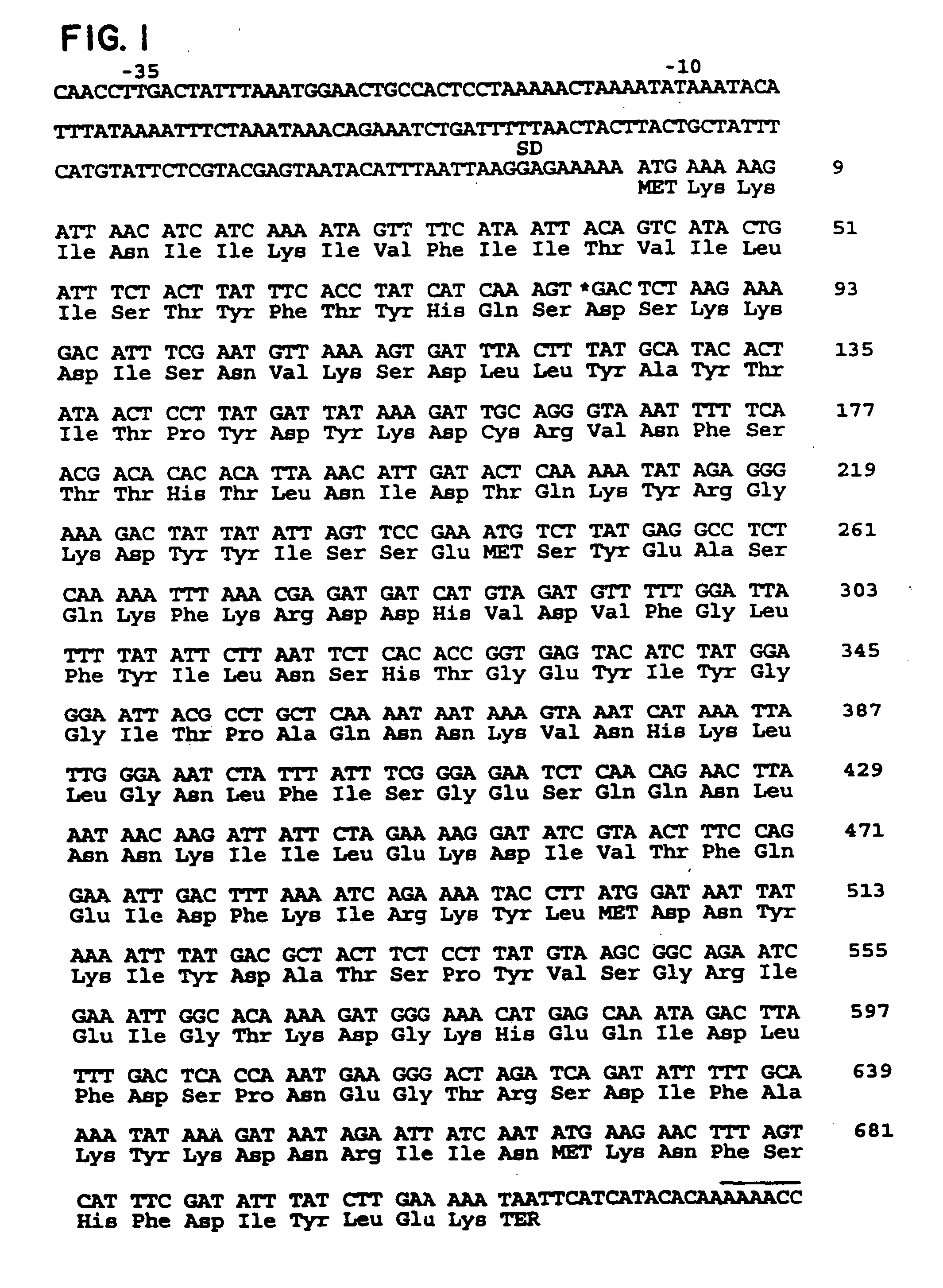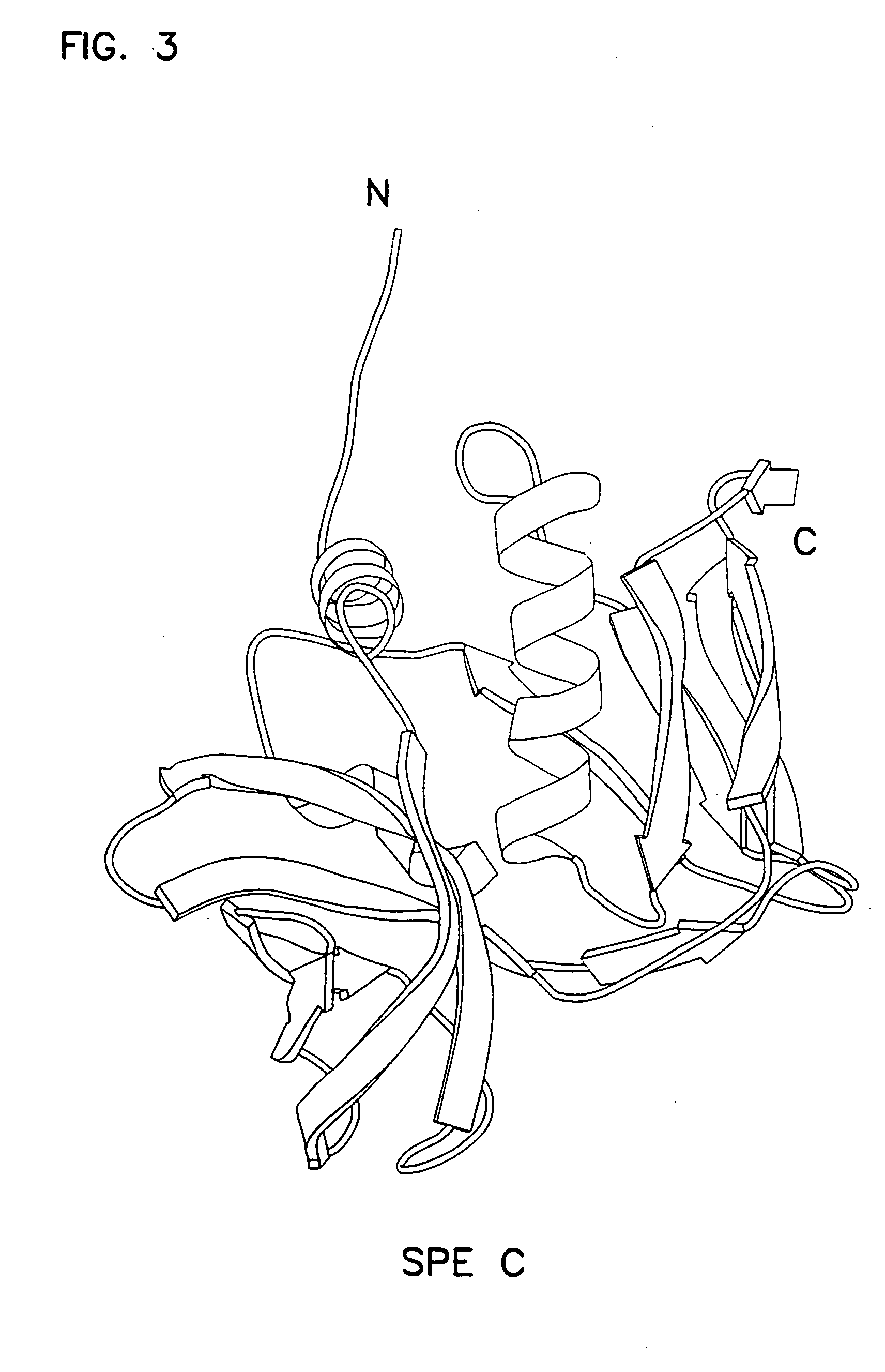Mutants of streptococcal toxin C and methods of use
a technology of streptococcal toxin and mutant streptococcal toxin, which is applied in the field of mutant streptococcal toxin and methods of use, can solve the problems of large problem of severe gas infection, abnormally high level of circulating cytokines, and inability to protect animals
- Summary
- Abstract
- Description
- Claims
- Application Information
AI Technical Summary
Benefits of technology
Problems solved by technology
Method used
Image
Examples
example 1
Cloning and Expression of SPE-C Wild Type
[0129] Cloning and Expression of speC in E. Coli
[0130] To obviate the need of toxin detection for gene isolation, oligonucleotides specific for the SPE-C gene were synthesized and used to screen a streptococcal genomic library. Purified streptococcal DNA from strain T18P was partially digested with the restriction endonuclease Sau 3A and separated on 0.7% agarose gel. Fragments in the 4-8 kilobase range were eluted from the gel and ligated to vector plasmid pBR328, which had been linearized with BAM H1 and dephosphorylated to prevent self-ligation. The ligated DNA was then used to transform competent E. coli RR1 cells to ampicillin resistance. Transformants were grown on nitrocellulose filters overlayed on LB agar containing ampicillin. Replica filters were prepared, and approximately 1500 recombinant colonies were screened for the presence of the speC gene by colony hybridization to radiolabeled synthetic oligonucleotides. Two families of ...
example 2
Biochemical Characterization of E. Coli-Derived SPE-C
[0133] SPE-C encoded by UMN 501 was partially purified from extracts of E. coli RR1 by ethanol precipitation followed by preparative isoelectric focusing in a pH gradient of 3.5-10. E. coli-derived toxin migrated to the same approximate location, (between 6.5 and 7.2), as the streptococcal-derived toxin. E. coli and streptococcal-derived SPE-C had identical molecular weights of 24000 in SDS-PAGE. Though additional proteins were present in the E. coli preparation, only the 24000 mw protein reacted when tested by an immunoblot technique using SPE-C-specific antiserun.
example 3
Biological Characterization of E. Coli-Derived SPE-C
[0134]E. coli and streptococcal-derived SPE-C were compared for lymphocyte mitogenicity. Rabbit splenocytes (2×105 cells) were exposed to approximately 0.01 ug SPE-C from S. pyogenes or E. coli(pUMN 501). After 3 days, the cultures were pulsed with 1 uCi [3H]-thymidine and incubated for 24 h, after which incorporation of radiolabel into cellular DNA was quantified. Both toxin preparations induced a similar mitogenic response. Incubation with SPE-C antiserum significantly reduced the mitogenic response of both cloned and streptococcal-derived toxin.
[0135] Streptococcal and E. coli-derived SPE-C were also compared for pyrogenicity and enhancement of lethal endotoxin shock in rabbits. The streptococcal and E. coli-derived SPE-C were equally pyrogenic; the average rise in temperature for both preparations was 1.0 C after 4 h. The fever responses were monophasic, rather than biphasic as is characteristic of endotoxin. This suggests th...
PUM
| Property | Measurement | Unit |
|---|---|---|
| Biological properties | aaaaa | aaaaa |
Abstract
Description
Claims
Application Information
 Login to View More
Login to View More - R&D
- Intellectual Property
- Life Sciences
- Materials
- Tech Scout
- Unparalleled Data Quality
- Higher Quality Content
- 60% Fewer Hallucinations
Browse by: Latest US Patents, China's latest patents, Technical Efficacy Thesaurus, Application Domain, Technology Topic, Popular Technical Reports.
© 2025 PatSnap. All rights reserved.Legal|Privacy policy|Modern Slavery Act Transparency Statement|Sitemap|About US| Contact US: help@patsnap.com



